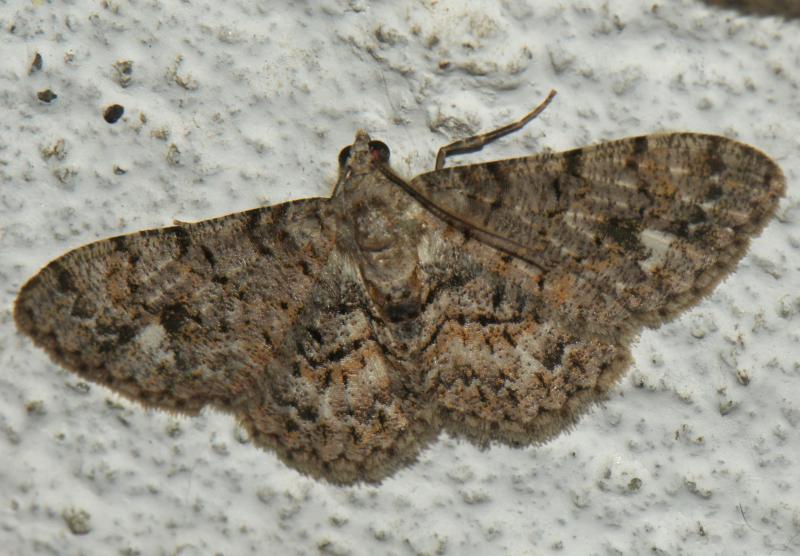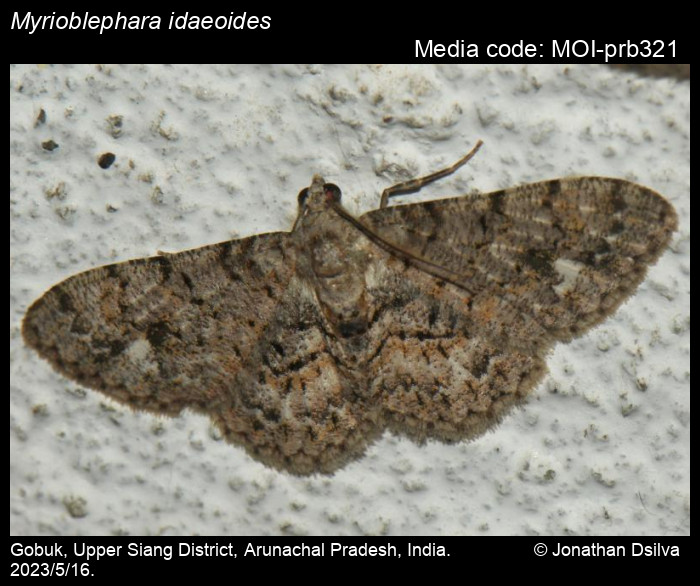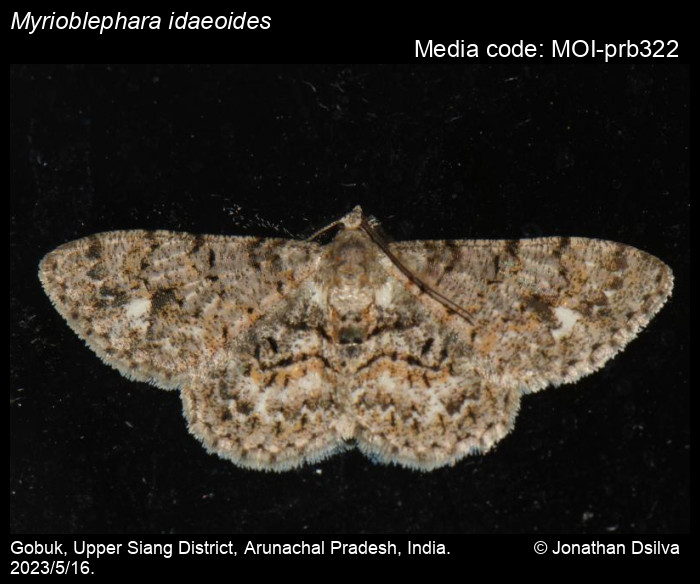Image


Life stage
Email (of contributor)
jd1073@yahoo.com
Notes (optional)
Myrioblephara idaeoides (Moore, 1888)
ssp : idaeoides
1) OD : Cleora idaeoides Moore, 1888 - Descr. New Indian lepid. Insects Colln. late Mr.Atkinson: 239 https://www.biodiversitylibrary.org/item/26805#page/257/mode/1up
2) Ectropis idaeoides - The Sarawak Museum journal, https://www.biodiversitylibrary.org/page/14620559#page/233/mode/1up
albipunctata was considered as a synonym
3) Boarmia idaeoides - Moths of India, Vol 3 pg 259 #3387 - https://www.biodiversitylibrary.org/item/67892#page/293/mode/1up simplaria was also considered as a synonym
4) https://v3.boldsystems.org/index.php/Taxbrowser_Taxonpage?taxid=466247
5) Moths of Nepal Part 2, Pl 36/20
6) https://www.inaturalist.org/taxa/868506-Myrioblephara-idaeoides
HW post-medial is angled centrally & close to the prominent discal mark.
Similar looking spp. –
Myrioblephara albipunctata Warren, 1893 - HW post-medial is smoothly curved rather than forming an angle centrally, with the discal mark not prominent. Moths of Nepal Part 3, Pl 75/5
Myrioblephara simplaria (Swinhoe, 1894) - the HW post-medial broadly loops around the discal mark. Moths of Nepal Part 3, Pl 75/5
https://www.mothsofborneo.com/part-11/Boarmiini/boarmiini_43_2.php reference & differences in the description of Myrioblephara bifida Holloway, 1993, extralimital
M. idaeoides, simplaria & albipunctata are considered as separate spp. upon examining genitalia by Sato in MON, Part 3 pg 49-50
RPS: Agree with ID.
SS: Are all three the same individual? The third one definitely looks different. Additional references
Moths of Laos, Vol. 25. pg. 82, Pl. 28/35. M. idaeoides, simplaria & albipunctata are all shown in the plate.
Sato, R and Stüning, D., 2013. Eleven new species of the genera Ectropidia Warren and Myrioblephara Warren (Geometridae, Ennominae) from Sulawesi and Maluku in Indonesia, with additional notes on species described earlier. Tinea, 22(3), pp.190-213.
Still examining how best to separate M. idaeoides, simplaria & albipunctata.
JD : yes, the 3rd one is a different individual, & have removed the image.
SS: Reviewed this species again and my notes below.
Myrioblephara simplaria (Swinhoe, 1894)
Ectropis simplaria Swinhoe, 1894; Trans. ent. Soc. Lond. 1894 (1): 221. TL: Cherrapunji. Text at https://archive.org/details/transactionsofen1894roya/page/221/mode/1up
SS: In Myrioblephara simplaria (Swinhoe, 1894), the space between the antemedial and discal lines on HW are much more than in albipunctata and idaeoides. Also, these lines have a dotted appearance and with black points (based on OD & plates in MON/MOL), rather than solid lines; hence this individual is not simplaria. Myrioblephara simplaria abdomen has black dorsal bands, based on the OD.
MON Part 3, Pl. 75/6.
https://www.mothsofborneo.com/species/myrioblephara-simplaria
https://www.inaturalist.org/taxa/516910-Myrioblephara-simplaria
Myrioblephara albipunctata Warren, 1893
Myrioblephara albipunctata Warren, 1893, Proc. zool. Soc. Lond. 1893 (2): 428. TL: Sikkim, Naga Hills. Text at https://www.biodiversitylibrary.org/page/35992692#page/518/mode/1up. OD states that second line on HW is “the second distinct, blackish, angulated in the middle, near the first, and enclosing the discal dot”, so the angulated line is present in this species as well.
Myrioblephara albipunctata, MON Part 3, Pl. 75/5.
Moths of Laos, Vol. 25. pg. 82, Pl. 28/34.
I do believe that Myrioblephara idaeoides (Moore, 1888) and Myrioblephara albipunctata Warren, 1893 are too similar to be told apart using images, and if they are separate species, then Myrioblephara idaeoides (Moore, 1888) takes preference. Hence, I am publishing this as Myrioblephara idaeoides (Moore, 1888), with a provisional ID.
ssp : idaeoides
1) OD : Cleora idaeoides Moore, 1888 - Descr. New Indian lepid. Insects Colln. late Mr.Atkinson: 239 https://www.biodiversitylibrary.org/item/26805#page/257/mode/1up
2) Ectropis idaeoides - The Sarawak Museum journal, https://www.biodiversitylibrary.org/page/14620559#page/233/mode/1up
albipunctata was considered as a synonym
3) Boarmia idaeoides - Moths of India, Vol 3 pg 259 #3387 - https://www.biodiversitylibrary.org/item/67892#page/293/mode/1up simplaria was also considered as a synonym
4) https://v3.boldsystems.org/index.php/Taxbrowser_Taxonpage?taxid=466247
5) Moths of Nepal Part 2, Pl 36/20
6) https://www.inaturalist.org/taxa/868506-Myrioblephara-idaeoides
HW post-medial is angled centrally & close to the prominent discal mark.
Similar looking spp. –
Myrioblephara albipunctata Warren, 1893 - HW post-medial is smoothly curved rather than forming an angle centrally, with the discal mark not prominent. Moths of Nepal Part 3, Pl 75/5
Myrioblephara simplaria (Swinhoe, 1894) - the HW post-medial broadly loops around the discal mark. Moths of Nepal Part 3, Pl 75/5
https://www.mothsofborneo.com/part-11/Boarmiini/boarmiini_43_2.php reference & differences in the description of Myrioblephara bifida Holloway, 1993, extralimital
M. idaeoides, simplaria & albipunctata are considered as separate spp. upon examining genitalia by Sato in MON, Part 3 pg 49-50
RPS: Agree with ID.
SS: Are all three the same individual? The third one definitely looks different. Additional references
Moths of Laos, Vol. 25. pg. 82, Pl. 28/35. M. idaeoides, simplaria & albipunctata are all shown in the plate.
Sato, R and Stüning, D., 2013. Eleven new species of the genera Ectropidia Warren and Myrioblephara Warren (Geometridae, Ennominae) from Sulawesi and Maluku in Indonesia, with additional notes on species described earlier. Tinea, 22(3), pp.190-213.
Still examining how best to separate M. idaeoides, simplaria & albipunctata.
JD : yes, the 3rd one is a different individual, & have removed the image.
SS: Reviewed this species again and my notes below.
Myrioblephara simplaria (Swinhoe, 1894)
Ectropis simplaria Swinhoe, 1894; Trans. ent. Soc. Lond. 1894 (1): 221. TL: Cherrapunji. Text at https://archive.org/details/transactionsofen1894roya/page/221/mode/1up
SS: In Myrioblephara simplaria (Swinhoe, 1894), the space between the antemedial and discal lines on HW are much more than in albipunctata and idaeoides. Also, these lines have a dotted appearance and with black points (based on OD & plates in MON/MOL), rather than solid lines; hence this individual is not simplaria. Myrioblephara simplaria abdomen has black dorsal bands, based on the OD.
MON Part 3, Pl. 75/6.
https://www.mothsofborneo.com/species/myrioblephara-simplaria
https://www.inaturalist.org/taxa/516910-Myrioblephara-simplaria
Myrioblephara albipunctata Warren, 1893
Myrioblephara albipunctata Warren, 1893, Proc. zool. Soc. Lond. 1893 (2): 428. TL: Sikkim, Naga Hills. Text at https://www.biodiversitylibrary.org/page/35992692#page/518/mode/1up. OD states that second line on HW is “the second distinct, blackish, angulated in the middle, near the first, and enclosing the discal dot”, so the angulated line is present in this species as well.
Myrioblephara albipunctata, MON Part 3, Pl. 75/5.
Moths of Laos, Vol. 25. pg. 82, Pl. 28/34.
I do believe that Myrioblephara idaeoides (Moore, 1888) and Myrioblephara albipunctata Warren, 1893 are too similar to be told apart using images, and if they are separate species, then Myrioblephara idaeoides (Moore, 1888) takes preference. Hence, I am publishing this as Myrioblephara idaeoides (Moore, 1888), with a provisional ID.
Name for copyright (do not include copyright symbol)
Jonathan Dsilva
Location (type location name here, or create a new location below under "Choose on the map")
HighLighted Contributions
No
Species Node
Overwrite img


Organism
Butterfly
Moth Taxon search:
Month
May
Year
2023
Day
16
Choose copyright license
Copyrighted (all rights reserved)